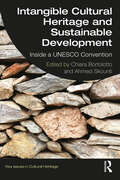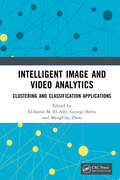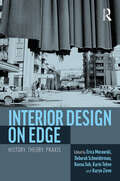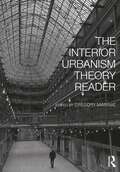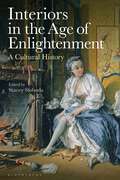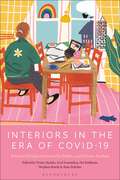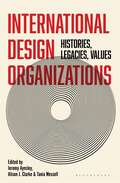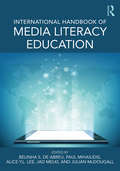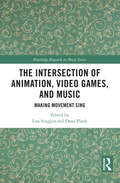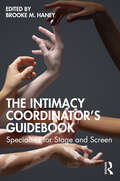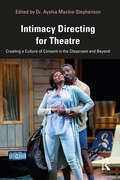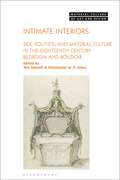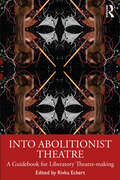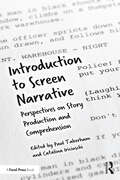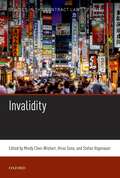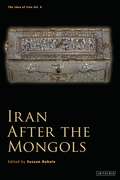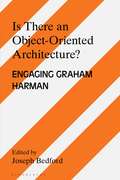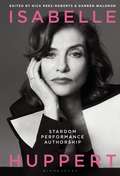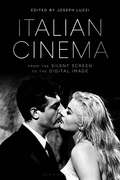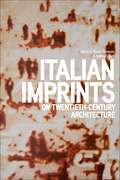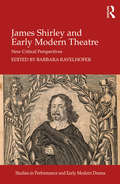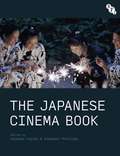- Table View
- List View
Intangible Cultural Heritage and Sustainable Development: Inside a UNESCO Convention (Key Issues in Cultural Heritage)
Drawing on debates about intangible cultural heritage (ICH) safeguarding at the local and international levels, Intangible Cultural Heritage and Sustainable Development: Inside a UNESCO Convention, explores the theoretical and practical implications of the intertwinement between these policy fields. Considering how sustainable development (SD) priorities are influencing representations of ICH, the volume questions how they are expanding the frontiers of the heritage realm and unsettling accepted understandings of the social uses of heritage. The contributing authors, who hail from a variety of different contexts and disciplinary backgrounds, explore these issues from a unique vantage point as both scholars and actors of the processes they analyze. Playing different roles in the implementation of the Convention, their positioning as insiders allows for a unique analytical perspective that is based on first-hand engagement with the practices of the Convention. Intangible Cultural Heritage and Sustainable Development: Inside a UNESCO Convention sheds light on the complexity, potential, and consequences of combining ICH and SD at the policy-making level and in heritage practices on the ground. It will be of interest to academics and students working in heritage studies, development studies, anthropology, archaeology, international law, political science, international relations, and sociology.
Intelligent Image and Video Analytics
Video has rich information including meta-data, visual, audio, spatial and temporal data which can be analysed to extract a variety of low and high-level features to build predictive computational models using machine-learning algorithms to discover interesting patterns, concepts, relations, and associations. This book includes a review of essential topics and discussion of emerging methods and potential applications of video data mining and analytics. It integrates areas like intelligent systems, data mining and knowledge discovery, big data analytics, machine learning, neural network, and deep learning with focus on multimodality video analytics and recent advances in research/applications. Features: Provides up-to-date coverage of the state-of-the-art techniques in intelligent video analytics. Explores important applications that require techniques from both artificial intelligence and computer vision. Describes multimodality video analytics for different applications. Examines issues related to multimodality data fusion and highlights research challenges. Integrates various techniques from video processing, data mining and machine learning which has many emerging indoors and outdoors applications of smart cameras in smart environments, smart homes, and smart cities. This book aims at researchers, professionals and graduate students in image processing, video analytics, computer science and engineering, signal processing, machine learning, and electrical engineering.
Interior Design on Edge: History, Theory, Praxis
Interior Design on Edge explores ways that interiors both constitute and upset our edges, whether physical, conceptual or psychological, imagined, implied, necessary or discriminatory.The essays in this volume explore these questions in history, theory, and praxis through a focus on different periods, cultures, and places. Interior Design on Edge showcases new scholarship that expands and contests traditional relationships between architecture, interiors, and the people that use and design them, provoking readers to consider the interior differently, moving beyond its traditional, architectural definition. Focusing on the concept of interiority considered in a wider sense, it draws on interdisciplinary modes of investigation and analysis and reflects the latest theoretical developments in the fields of interior design history and practice.With new research from both established and emerging authors, this volume will make a valuable contribution to the fields of Interior Design, Architecture, Art and Design History, Cultural History, Visual Culture Studies, and Urban Studies.
The Interior Urbanism Theory Reader
The Interior Urbanism Theory Reader expands our understanding of urbanism, interiority, and publicness from a global perspective across time and cultures. From ancient origins to speculative futures, this book explores the rich complexities of interior urbanism as an interstitial socio-spatial condition. Employing an interdisciplinary lens, it examines the intersectional characteristics that define interior urbanism. Fifty chapters investigate the topic in relation to architecture, planning, urban design, interior architecture, interior design, archaeology, engineering, sociology, psychology, and geography. Individual essays reveal the historical, typological, and morphological origins of interior urbanism, as well as its diverse scales, occupancies, and atmospheres. The Interior Urbanism Theory Reader will appeal to scholars, practitioners, students, and enthusiasts of urbanism, architecture, planning, interiors, and the social sciences.
Interiors in the Age of Enlightenment: A Cultural History
Interiors in the Age of Enlightenment provides a comprehensive and interdisciplinary overview of the cultural history of interior design and interior spaces from 1700 to 1850.Considering the interior as material, social and cultural artefact, this volume moves beyond conventional descriptive accounts of changing styles and interior design fashions, to explore in depth the effect on the interior of the materials, processes, aesthetic philosophies and cultural attitudes of the age.From the Palace of Versailles to Virginia coffeehouses, and from Chinoiserie bathhouses to the trading exchanges of the West Indies, the chapters in this book examine a wide range of themes including technological advancements, public spaces, gender and sexuality, and global movements in interior designs and decorations. Drawing together contributions from leading scholars, this volume provides the most authoritative and comprehensive survey of the history of interiors and interior architecture in the long eighteenth century.
Interiors in the Era of Covid-19: Interior Design between the Public and Private Realms
The Covid-19 lockdowns caused people worldwide to be confined to their homes for longer and on a greater scale than ever before. This forced many unprecedented changes to the way we treat domestic space – as relationships shifted between the public and the private worlds, and homes were rapidly adapted to accommodate the additional roles of schools, offices, gyms, restaurants, making-spaces and more. Above all, our understanding of the home as a site to support and enhance the well-being of its inhabitants changed in a variety of novel ways. Interiors in the Era of Covid is a collection of essays which explore the complex ways in which our inside spaces (contemporary and historical) have responded to Covid-19 and other human crises. With case studies ranging from US and Europe to Japan, China, Colombia, and Bangladesh, this is a truly global work which examines wide-ranging subjects from home-working and home technologies, to the impact of lockdown on people's identities, gender roles in the home, and the realities of domestic living with Covid in refugee camps. Exploring the roles played by designers (both amateur and professional) in accommodating changing requirements and anticipating future ones – whether Covid or beyond – this book is a must-read for students and researchers in interior design, architecture, architectural and design history, and anyone interested in the home and the relationships between health and design.
International Design Organizations: Histories, Legacies, Values
This innovative volume brings together international design scholars to address the history and present-day status of national and international design organizations, working across design disciplines and located in countries including Argentina, Turkey, Estonia, Switzerland, Italy, China and the USA.In the second half of the 20th century, many non-governmental organizations were created to address urgent cultural, economic and welfare issues. Design organizations set out to create an international consensus for the future direction of design. This included enhancing communication between professionals, educators and practitioners, raising standards for design, and creating communities of designers across linguistic, national and political borders. Shared needs and agendas were identified and categories of design constantly defined and re-defined, often with overt cultural and political intents.Drawing on an impressive range of original research, archival sources and oral testimony, this volume questions the aims and achievements of national and international design organizations in light of their subsequent histories and their global remits. The Cold War period is central to the book, while many chapters draw on post-colonial perspectives to interpret how transnational networks and negotiations took place at events and congresses, and through publication.
International Handbook of Media Literacy Education
At the forefront in its field, this Handbook examines the theoretical, conceptual, pedagogical and methodological development of media literacy education and research around the world. Building on traditional media literacy frameworks in critical analysis, evaluation, and assessment, it incorporates new literacies emerging around connective technologies, mobile platforms, and social networks. A global perspective rather than a Western-centric point of view is explicitly highlighted, with contributors from all continents, to show the empirical research being done at the intersection of media, education, and engagement in daily life. Structured around five themes—Educational Interventions; Safeguarding/Data and Online Privacy; Engagement in Civic Life; Media, Creativity and Production; Digital Media Literacy—the volume as a whole emphasizes the competencies needed to engage in meaningful participation in digital culture.
The Intersection of Animation, Video Games, and Music: Making Movement Sing (Routledge Research in Music)
In both video games and animated films, worlds are constructed through a combination of animation, which defines what players see on the screen, and music and sound, which provide essential cues to action, emotion, and narrative. This book offers a rich exploration of the intersections between animation, video games, and music and sound, bringing together a range of multidisciplinary lenses. In fourteen chapters, the contributors consider similarities and differences in how music and sound structure video games and animation, as well as the animation within video games, and explore core topics of nostalgia, adaptation, gender and sexuality. Offering fresh insights into the aesthetic interplay of animation, video games, and sound, this volume provides a gateway into new areas of study that will be of interest to scholars and students across musicology, animation studies, game studies, and media studies more broadly.
The Intimacy Coordinator's Guidebook: Specialties for Stage and Screen
The Intimacy Coordinator's Guidebook: Specialties for Stage and Screen explores the role of the intimacy choreographer with an in-depth look at specializations that exist within the profession.With contributions by over 30 industry professionals, this book aims to bring awareness to a wide range of needs a project may have and how intimacy professionals use their cultural competency specialists in practice to create the most compelling storytelling. In Part One, the book addresses the scope of practice of an intimacy professional by discussing competency, finding your lens and tangential fields in the industry like fight directors, mental health coordinators and cultural competency specialists. Part Two covers specialties like working with minors, prosthetics, intimacy and disability, staging queer intimacy, working with fat actors, Black American intimacy, dance, working on scenes of trauma, sexual violence and non-consent, and BDSM. Between each chapter is a conversation with an actor, director or producer on their experiences working with an intimacy coordinator. In Part Three, the book looks at what it means to be qualified and intimacy professionals' hopes for the future of the industry.The Intimacy Coordinator's Guidebook is an invaluable resource for directors and producers looking to hire an intimacy professional, as well as in-depth study for those who are training or practicing in the field of intimacy for performance.
Intimacy Directing for Theatre: Creating a Culture of Consent in the Classroom and Beyond
Intimacy Directing for Theatre provides much needed strategies on how teachers and artists can do intimacy work in the classroom and rehearsal room that is safe and just. This book puts forth intimacy work that is based on human rights and consent for everyone, fully integrating justice with intimacy directing. It offers practical advice on how instructors can do intimacy work in their courses and productions that is based on consent and racial and gender justice. Each chapter is written by an instructor and professional practitioner who offers their perspective and experience on how to cultivate a space that is safe and intersectional, as well as respectful of students’ race, gender, sexual orientation, and other integral modes of identity. Chapters contain "low stakes" exercises that help to keep the rehearsal room safe, consensual, and inclusive. Intimacy Directing for Theatre is an excellent resource for Theatre & Performance instructors and practitioners who want to create and sustain a culture of consent in their classrooms and rehearsal rooms.
Intimate Interiors: Sex, Politics, and Material Culture in the Eighteenth-Century Bedroom and Boudoir (Material Culture of Art and Design)
A desire for intimacy in domestic spaces – motivated by a growing sense of individualistic expression, an incentive to conceal the labor or enslavement taking place, and an appetite for solace and comfort – led to interiors taking on more specific roles in the eighteenth century. By examining the architectural, visual, and material culture of eighteenth-century spaces, Intimate Interiors foregrounds the interrelated concepts of intimacy, privacy, informality, and sociability in order to show how these ideas played an increasingly integral role in the period's architectural and material design.Across eleven innovative chapters that explore issues of gender, politics, travel, exoticism, imperialism, sensorial experiences, identity, interiority, and modernity, this volume demonstrates how intimacy was a fundamental goal in the planning of private quarters. In doing so, the political nature of private spaces is uncovered, whilst highlighting the contradictions and complexities of these highly performative “private” interiors. Employing distinct methodological perspectives across various geographical sites, from Turkey to Versailles, Britain to Benin, Intimate Interiors draws as-yet untraced connections between Enlightenment Europe, imperial outposts, and major metropolitan centers across the globe.
Into Abolitionist Theatre: A Guidebook for Liberatory Theatre-making
Seeking to transform community-based theatre-making, this book explores the transformative potential of abolitionist theatre, as theatre artists and teachers collaborate with marginalized communities to challenge systems of oppression and inspire profound societal change.Focusing on the idea of bringing people together to demand collective care and community-led practice, this collection works to define theatre’s role in the goals of abolition. Abolitionist theatre-making is a theatre that is connected to the practice of decolonization, intersectional feminism, climate justice, social justice, and liberation struggles. Exploring these ideas and offering a direct exploration of the questions that theatre artists and teachers should ask themselves when evaluating the abolitionist impact of their work, the volume provides accessible and practical tools for theatre-makers with perspectives from working practitioners throughout. Through real-life stories and experiences shared by theatre practitioners, the book provides a rich and diverse tapestry of examples that highlight the ways in which community-based theatre can contribute to transformational change. Readers will benefit from practical frameworks, thought-provoking perspectives, and thoughtfully crafted insights that inspire them to reimagine their own theatre practices and empower them to create theatre that challenges and dismantles oppressive systems while uplifting marginalized voices.Ideal for undergraduate and graduate students with an interest in utilizing theatre-making for social change, this book offers new and practical insights into how the path to abolition might be laid and theatre’s key role in it. This book will also be of great interest to theatre artists and activist practitioners who are involved in community-based theatre projects with marginalized populations.
Introduction to Screen Narrative: Perspectives on Story Production and Comprehension
Bringing together the expertise of world-leading screenwriters and scholars, this book offers a comprehensive overview of how screen narratives work. Exploring a variety of mediums including feature films, television, animation, and video games, the volume provides a contextual overview of the form and applies this to the practice of screenwriting. Featuring over 20 contributions, the volume surveys the art of screen narrative, and allows students and screenwriters to draw on crucial insights to further improve their screenwriting craft. Editors Paul Taberham and Catalina Iricinschi have curated a volume that spans a range of disciplines including screenwriting, film theory, philosophy and psychology with experience and expertise in storytelling, modern blockbusters, puzzle films and art cinema. Screenwriters interviewed include: Josh Weinstein (The Simpsons, Gravity Falls), David Greenberg (Stomping Ground, Used to Love Her), Evan Skolnick and Ioana Uricaru. Ideal for students of Screenwriting and Screen Narrative as well as aspiring screenwriters wanting to provide theoretical context to their craft.
Invalidity (Studies in the Contract Laws of Asia)
Studies in the Contract Laws of Asia provides an authoritative account of the contract law regimes of selected Asian jurisdictions, including the major centres of commerce where limited critical commentaries have been published in the English language. Each volume in the series aims to offer an insider's perspective into specific areas of contract law - remedies, formation, parties, contents, vitiating factors, change of circumstances, illegality, and public policy - and explores how these diverse jurisdictions address common problems encountered in contractual disputes. A concluding chapter draws out the convergences and divergences, and other themes. All the Asian jurisdictions examined have inherited or adopted the common law or civil law models of European legal systems. Scholars of legal transplant will find a mine of information on how received law has developed after the initial adaptation and transplant process, including the mechanisms of and influences affecting these developments. At the same time, many points of convergence emerge. These provide good starting points for regional harmonization projects. Volume IV of Studies in the Contract Laws of Asia deals with factors affecting the validity of contracts (mistake, fraud, misrepresentation, coercion, and unfair exploitation) in the laws of China, Hong Kong, India, Indonesia, Japan, Korea, Malaysia, Myanmar, the Philippines, Singapore, Taiwan, Thailand, and Vietnam.Typically, each jurisdiction is covered in two chapters; the first deals with erroneous beliefs, while the second deals with reprehensible conduct of one of the contracting parties.
Iran After the Mongols (The Idea of Iran)
Following the devastating Mongol conquest of Baghdad in 1258, the domination of the Abbasids declined leading to successor polities, chiefly among them the Ilkhanate in Greater Iran, Iraq and the Caucasus. Iranian cultural identities were reinstated within the lands that make up today's Iran, including the area of greater Khorasan. The Persian language gained unprecedented currency over Arabic and new buildings and manuscripts were produced for princely patrons with aspirations to don the Iranian crown of kingship. This new volume in “The Idea of Iran” series follows the complexities surrounding the cultural reinvention of Iran after the Mongol invasions, but the book is unique capturing not only the effects of Mongol rule but also the period following the collapse of Mongol-based Ilkhanid rule. By the mid-1330s the Ilkhanate in Iran was succeeded by alternative models of authority and local Iranian dynasties. This led to the proliferation of diverse and competing cultural, religious and political practices but so far scholarship has neglected to produce an analysis of this multifaceted history in any depth. Iran After the Mongols offers new and cutting-edge perspectives on what happened. Analysing the fourteenth century in its own right, Sussan Babaie and her fellow contributors capture the cultural complexity of an era that produced some of the most luminous masterpieces in Persian literature and the most significant new building work in Tabriz, Yazd, Herat and Shiraz. Featuring contributions by leading scholars, this is a wide-ranging treatment of an under-researched period and the volume will be essential reading for scholars of Iranian Studies and Middle Eastern History.
Ireland: The Matter of Monuments
This collection considers Irish monuments from the medieval to the modern era. The essays presented here acknowledge the plurality of values associated with Irish monuments. Taking a holistic approach to the topic, the volume contains contributions from art historians, archaeologists, historians and heritage practitioners. The multidisciplinary and intersectoral contributions are placed in dialogue with one another, providing a discussion of Irish monuments that is unique in its comprehensiveness. The integration of research on early Irish monumental work with that of the more modern period, situating all Irish monuments on a continuum of shared concerns, is a significant pioneering element in this field. The range of perspectives represented in the book reflects the complexity of cultural heritage in contemporary life and opens the conversation to include a wider range of views. It will be a valuable resource for scholars, students, learned societies, public bodies, communities in Ireland and for anyone interested in sculpture. An Open Access version of Kathleen James-Chakraborty's chapter 'New states and old statues: Ireland's monuments in an international context' will be made available on publication.
Ireland: The Matter of Monuments
This collection considers Irish monuments from the medieval to the modern era. The essays presented here acknowledge the plurality of values associated with Irish monuments. Taking a holistic approach to the topic, the volume contains contributions from art historians, archaeologists, historians and heritage practitioners. The multidisciplinary and intersectoral contributions are placed in dialogue with one another, providing a discussion of Irish monuments that is unique in its comprehensiveness. The integration of research on early Irish monumental work with that of the more modern period, situating all Irish monuments on a continuum of shared concerns, is a significant pioneering element in this field. The range of perspectives represented in the book reflects the complexity of cultural heritage in contemporary life and opens the conversation to include a wider range of views. It will be a valuable resource for scholars, students, learned societies, public bodies, communities in Ireland and for anyone interested in sculpture. An Open Access version of Kathleen James-Chakraborty's chapter 'New states and old statues: Ireland's monuments in an international context' is available on the Liverpool University Press website.
Is there an Object Oriented Architecture?: Engaging Graham Harman (Architecture Exchange: Engagements with Contemporary Theory and Philosophy)
Bringing Graham Harman's philosophy into direct confrontation with contemporary architectural theory in new and creative ways, Is There an Object-Oriented Architecture? provides a dialogue between Harman and six of the world's leading architectural thinkers, Adam Sharr, Lorens Holm, Jonathan Hale, Peg Rawes, Patrick Lynch and Peter Carl. Harman's object-oriented philosophy is one that sees the universe as a carnival of equal “objects” with no hierarchy between humans and nonhumans. In his model, unicorns, triangles, bicycles, neutrons, and humans are all things with enduring essences that outlast their partial transformations. It is a strikingly democratic vision of the universe that knocks humans off their ontological pedestal as arbiters of what is real. It also radically challenges the very precepts of architectural theory, the structure of which remains stubbornly human-centric as it seeks to give form to the human being's place at the centre of the cosmos. In this new book, each thinker develops the implications of Harman's philosophy for the future of architecture by entering into a direct exchange with the philosopher and his thinking, both questioning him and questioning with him.
Isabelle Huppert: Stardom, Performance, Authorship
Featuring a lineup of distinguished academics, this collection remedies the absence of scholarly attention on French cinematic legend Isabelle Huppert. This volume deconstructs Huppert's star persona and public profile through critical and theoretical analysis of her various screen roles-from her very early appearances alongside Romy Schneider in César et Rosalie (Sautet, 1972) and Gérard Depardieu in Les Valseuses (1974) to a number of celebrated collaborations with high-profile European auteurs such as Catherine Breillat, Claire Denis, Jean-Luc Godard, Michael Haneke and Joseph Losey, and with more popular auteurs such as Claude Chabrol and François Ozon. Known for a cerebral internalization of characterization, a technical mastery of extreme emotions, and a singular brand of icy intellectualism, Huppert's performances continue to impress, stun and surprise audiences. By focusing on several theoretical questions that relate to image, identity, sexuality and place, this volume situates Huppert's star persona in the more practical creative contexts of performance, authorship, genre and collaboration. This volume contrasts complementary critical accounts of her stardom by working across the different periods and territories of her career.
Italian Cinema from the Silent Screen to the Digital Image
In this comprehensive guide, some of the world's leading scholars consider the issues, films, and filmmakers that have given Italian cinema its enduring appeal. Readers will explore the work of such directors as Federico Fellini, Michelangelo Antonioni, and Roberto Rossellini as well as a host of subjects including the Italian silent screen, the political influence of Fascism on the movies, lesser known genres such as the giallo (horror film) and Spaghetti Western, and the role of women in the Italian film industry. Italian Cinema from the Silent Screen to the Digital Image explores recent developments in cinema studies such as digital performance, the role of media and the Internet, neuroscience in film criticism, and the increased role that immigrants are playing in the nation's cinema.
Italian Imprints on Twentieth-Century Architecture
Italian architecture has long exerted a special influence on the evolution of architectural ideas elsewhere - from the Beaux-Arts academy's veneration of Rome, to modernist and postmodern interest in Renaissance proportion, Baroque space, and Mannerist ambiguity. This book critically examines this enduring phenomenon, exploring the privileged position of Italian architects, architecture, and cities in the architectural culture of the past century.Questioning the deep-rooted myth of Italy within architectural history, the book presents case-studies of Italy's powerful yet problematic position in 20th-century architectural ideologies, at a time when established Eurocentric narratives are rightly being challenged. It reconciles the privileged position of Italian architecture and design with the imperative to write history across a more global, diverse, heterogenous cultural geography. 20 chapters from distinguished international scholars cover subjects and architects ranging from Alberti to Gio Ponti, Aldo Rossi, Manfredo Tafuri, Vittorio Gregotti; cities from Rome and Venice to Milan; and an array of international architects, movements, and architectural ideas influenced by Italy. The chapters each question where, how, and why the disciplinary edifice of 20th-century architecture-its canon of built, visual, textual, and conceptual works-relied on Italian foundations, examining where and how those foundations have become insecure.Indispensable for students and scholars of both Italian and global architectural history, Italian Imprints on Twentieth-Century Architecture provides an opportunity to consider the architectural and urban landscape of Italy from substantially new points of view.
Jamaica Making: The Theresa Roberts Art Collection
This book accompanies the first exhibition entirely of Jamaican art to take place in the north-west of the UK. The exhibition, Jamaica Making: The Theresa Roberts Art Collection, is sited at the Victoria Gallery and Museum, Liverpool in 2022, and is a comprehensive presentation of the best of Jamaican art since the 1960s. The Theresa Roberts Art Collection is the private collection of Theresa Roberts, a Jamaican-born businesswoman and philanthropist, who has made the UK her home. This collection offers an important insight into the development of Jamaican art since the country gained independence in 1962. Indeed, the exhibition also acts to commemorate the 60th anniversary of Jamaican independence in 2022. Included in the book are the following: an official welcome from the Prime Minister of Jamaica; an essay by the collector, exhibition donor and philanthropist, Theresa Roberts; an introduction by eminent British-Jamaican art historian, Edward Lucie-Smith; essays by Emma Roberts, the exhibition curator (Liverpool John Moores University), Davinia Gregory-Kameka, writer, educator and researcher (Columbia University, USA) and Sireita Mullings, arts practitioner and visual sociologist (University of Bedfordshire). The final section of the book is the full visual catalogue of the Jamaica Making exhibition – a unique record of this historic exhibition. An Open Access edition of this book is available on the Liverpool University Press website and the OAPEN library.
James Shirley and Early Modern Theatre: New Critical Perspectives (Studies in Performance and Early Modern Drama)
James Shirley was the last great dramatist of the English Renaissance, shining out among other luminaries such as John Ford, Ben Jonson, or Richard Brome. This collection considers Shirley within the culture of his time, and highlights his contribution to seventeenth-century English literature as poet and playwright. Individual essays explore Shirley’s musical theatre and spoken verse, performance conditions, female agency and politics, and the presentation of his work in manuscript and print. Collectively, the essays assemble a larger picture of Caroline drama, showing it to be more than simply a nostalgic endgame, its poets daintily sipping hemlock on the eve of the Civil Wars. Shirley’s literary versatility and long life, spanning the last days of Queen Elizabeth I to the ascension of Charles II, make him an ideal writer through whom to examine the distinctive qualities of Caroline theatre.
The Japanese Cinema Book
The Japanese Cinema Book provides a new and comprehensive survey of one of the world's most fascinating and widely admired filmmaking regions. In terms of its historical coverage, broad thematic approach and the significant international range of its authors, it is the largest and most wide-ranging publication of its kind to date.Ranging from renowned directors such as Akira Kurosawa to neglected popular genres such as the film musical and encompassing topics such as ecology, spectatorship, home-movies, colonial history and relations with Hollywood and Europe, The Japanese Cinema Book presents a set of new, and often surprising, perspectives on Japanese film.With its plural range of interdisciplinary perspectives based on the expertise of established and emerging scholars and critics, The Japanese Cinema Book provides a groundbreaking picture of the different ways in which Japanese cinema may be understood as a local, regional, national, transnational and global phenomenon.The book's innovative structure combines general surveys of a particular historical topic or critical approach with various micro-level case studies. It argues there is no single fixed Japanese cinema, but instead a fluid and varied field of Japanese filmmaking cultures that continue to exist in a dynamic relationship with other cinemas, media and regions.The Japanese Cinema Book is divided into seven inter-related sections: · Theories and Approaches· * Institutions and Industry· * Film Style· * Genre· * Times and Spaces of Representation· * Social Contexts· * Flows and Interactions
